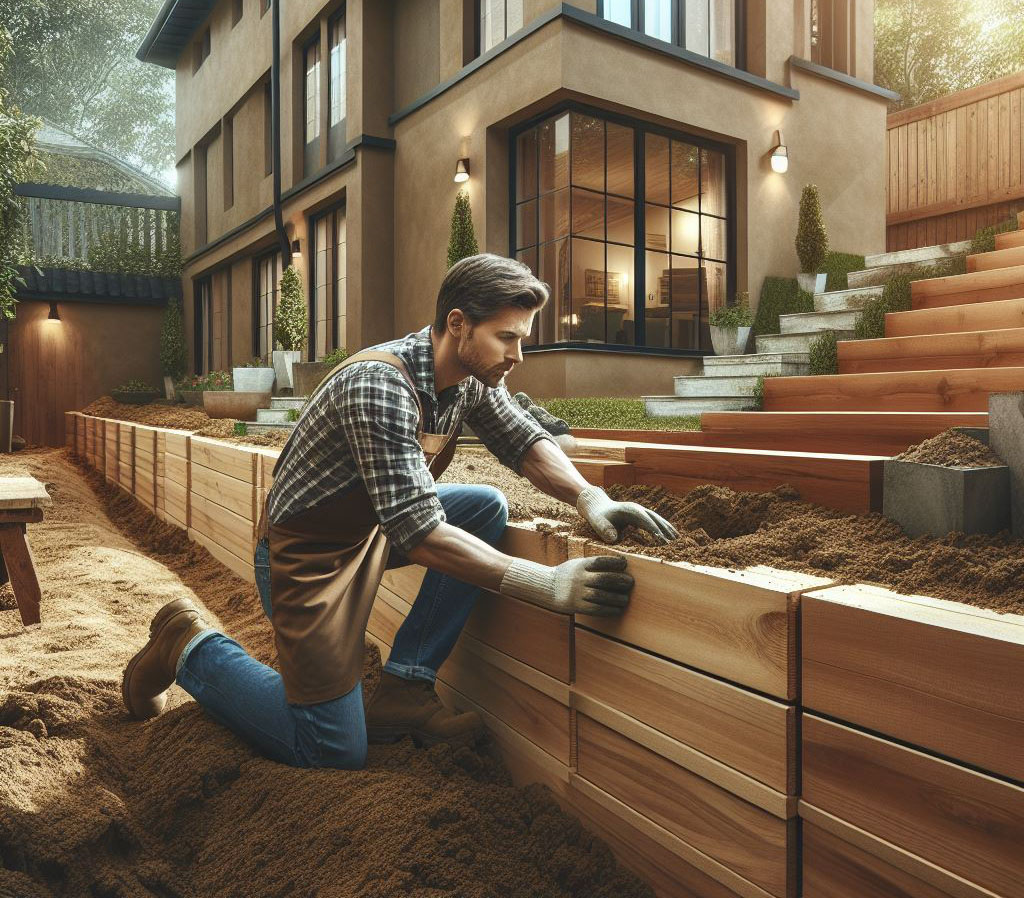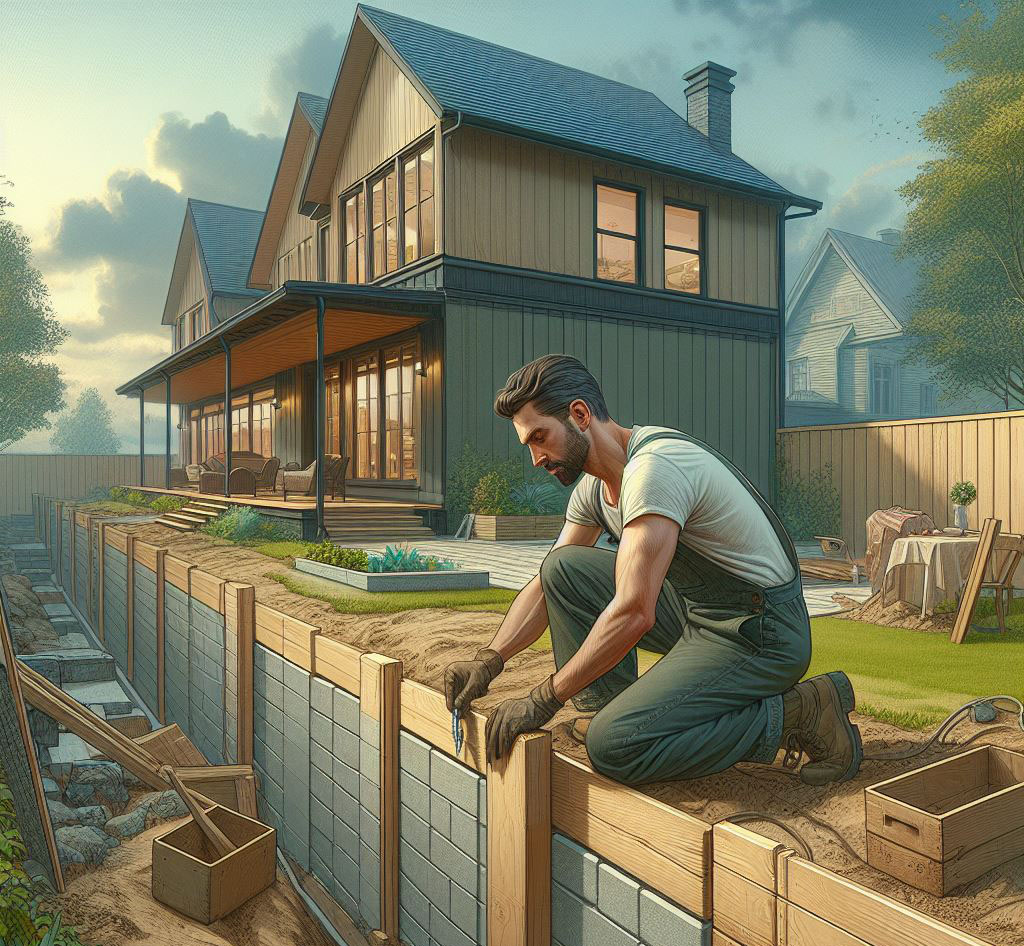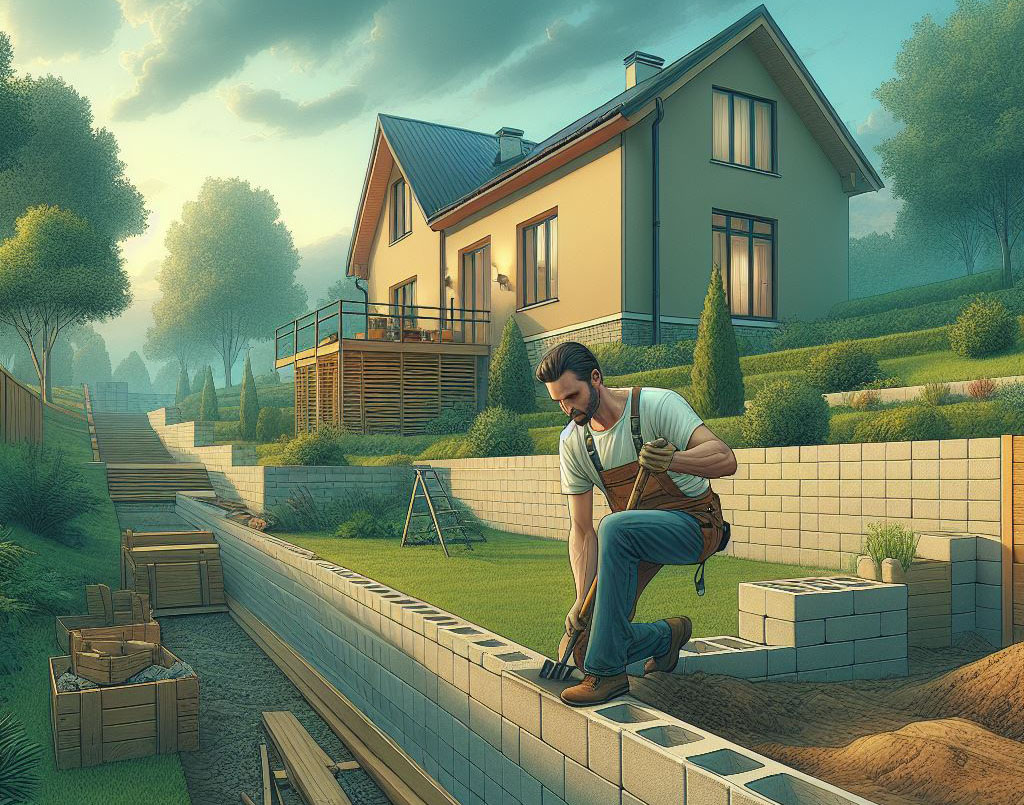When embarking on the construction of a retaining wall, the choice of material isn’t merely a matter of aesthetics—it’s foundational to the project’s success. A retaining wall serves a critical function, grappling with the forces of nature to protect your landscape from erosion and manage water flow. Selecting the right material is akin to laying the cornerstone of a building, it determines the strength, longevity, and beauty of the entire structure.

Understanding Retaining Walls
Retaining walls are more than mere decorative elements, they are engineering feats that hold back the earth, combating the lateral pressure exerted by sloping ground. A well-constructed wall is a bulwark against the forces of erosion, but its strength and stability are heavily reliant on the quality of materials and installation. Every choice in the construction process, from the material to the method, has lasting implications for the wall’s durability.
Factors to Consider Before Choosing Materials
The path to choosing the right material for your retaining wall is paved with careful consideration of several key factors:
- Soil Type and Pressure: Like the temperament of the sea, soil has its moods and movements. Some, like clay, are prone to expansion and contraction, demanding a material that can withstand constant shifts.
- Climate and Weather Resistance: Your material should be as resilient as a seasoned sailor, capable of weathering the storms of rain, snow, and sun.
- Aesthetic Preferences: While the primary role of a retaining wall is functional, it also plays a significant part in the visual symphony of your landscape. The material should harmonize with its surroundings, enhancing the natural beauty of your property.
- Budget and Maintenance Requirements: A prudent choice balances upfront costs with the long-term investment of time and resources in maintenance. Your material should stand steadfast without draining your resources or your time.

Popular Retaining Wall Materials
Through the lens of practical experience, let’s examine the attributes of common retaining wall materials:
- Timber: Timber is the quintessence of natural charm and simplicity. It’s accessible, workable, and blends seamlessly with the landscape. However, it’s not without its vulnerabilities—moisture and insects can be relentless foes, and regular maintenance is its companion.
- Concrete Blocks: These are the stalwarts of retaining walls. With a diverse range of designs and an impressive lifespan, concrete blocks are a testament to strength and stability. They may require a more substantial initial investment and skilled installation, but their durability offers peace of mind.
- Stone: Incorporating stone into your retaining wall is like weaving the essence of the earth into your landscape. It’s robust, enduring, and each stone is a unique piece of natural art. The investment reflects its value, demanding both a higher material cost and skilled craftsmanship.
- Gabion: Gabion walls are a testament to both strength and ingenuity, pairing rugged stone with the flexibility of wire. They offer excellent drainage, durability, and a distinctive aesthetic. While they can be a DIY endeavor, a thoughtful approach to their construction is crucial.
Timber Retaining Walls
In the realm of landscaping, timber retaining walls strike a charming balance between natural aesthetics and cost-effectiveness, making them a favored choice for many homeowners. However, they’re not without their challenges. Timber is inherently susceptible to nature’s whims – moisture can lead to rot, and insects, particularly termites, find it quite inviting. When installing, it’s crucial to use treated wood and elevate it off the soil, typically by constructing a sturdy gravel base. Proper drainage is your ally in preserving the integrity of timber. Regular maintenance, such as inspecting for signs of deterioration like rot or warping, ensures longevity. Promptly replacing compromised sections can save the whole structure from potential failure.

Concrete Blocks
For those seeking a blend of resilience and aesthetic versatility, concrete blocks are a solid choice. Renowned for their durability and low maintenance, they offer a variety of design options to suit any landscape. However, this strength comes at a price, both in terms of cost and the complexity of installation. Modern concrete block designs push the boundaries of functionality and style, making them a compelling option for contemporary spaces. Precision in laying a level foundation and meticulous attention to backfill and drainage are non-negotiable for ensuring the longevity of these structures. Though more labor-intensive and costly upfront, the enduring nature of concrete blocks can offer peace of mind and a lasting return on investment.
Stone and Boulder Walls
Stone and boulder walls are the embodiment of natural elegance and time-tested durability, each stone narrating its geological history. However, the authenticity and uniqueness of these materials come with a higher price tag and necessitate skilled craftsmanship. The selection of stone is not merely an aesthetic decision but a structural one. Opt for stones known for their durability and ability to withstand environmental pressures. The construction of these walls is akin to assembling a complex jigsaw puzzle, with each stone meticulously chosen and placed for optimal stability and visual appeal. Incorporating adequate landscaping drainage solutions ensures that the beauty and integrity of the wall endure through the seasons.
Gabion Walls
Gabion walls, with their distinctive blend of functionality and aesthetic appeal, are gaining popularity in contemporary landscaping. These structures, essentially wire baskets filled with rocks, excel in strength, water permeability, and visual interest. Their installation is relatively straightforward: assemble the wire baskets, fill them with the chosen rocks, and the structure is set. They are particularly suited for areas requiring robust support with an aesthetic touch. Ensuring a proper fit of the rocks within the baskets is crucial for the stability and appearance of the wall. Gabion walls stand as a testament to the harmonious marriage of practicality and style in modern landscaping.
DIY Retaining Wall Ideas
Building your own timber or block retaining wall can be both a challenging and fulfilling DIY project. When considering timber, select pressure-treated wood to withstand the elements, and don’t forget to create a robust gravel base for stability. For block walls, interlocking concrete blocks offer a straightforward assembly and provide a modern look. Key to your project’s success is a firm foundation, take the time to dig an appropriate footing and establish a solid gravel base. Incorporating adequate drainage, such as a French drain system behind the wall, is crucial to prevent water buildup and ensure the longevity of your wall.
Modern Trends in Retaining Wall Design
Today’s retaining walls transcend their utilitarian roots, evolving into elements of design that accentuate the landscape. Wood retaining walls, particularly those using reclaimed or specially treated wood, are gaining popularity for their blend of rustic charm and contemporary sophistication. Innovations in design are seen in the use of geometric patterns, diverse textures, and the incorporation of green elements like built-in planters. The essence of modern retaining wall design lies in achieving the perfect balance between aesthetic appeal and structural integrity.
Maintenance and Longevity
Maintaining your retaining wall is pivotal in extending its lifespan. For timber walls, be vigilant for signs of rot or insect infestation and address any issues promptly by replacing affected timber. In stone or concrete block walls, monitor the condition of mortar joints and ensure they remain intact. Regularly remove debris or vegetation that may retain moisture and compromise the wall’s integrity. Crucially, ensure that drainage systems, such as weep holes or drainage pipes, remain unobstructed to prevent water from accumulating and exerting pressure on the wall.
FAQ Section
While timber is generally the most cost-effective choice, it’s important to consider long-term maintenance and durability in your overall cost assessment.
Yes, particularly with block or timber materials. However, be mindful of the risks associated with improper installation, such as structural failure. Thoroughly understanding proper construction techniques and adhering to local building codes is essential.
Consider the specifics of your project, including the wall’s height, the load it needs to support, and your local climate. Also, think about the aesthetic you wish to achieve. Interlocking concrete blocks are generally user-friendly and versatile.
Indicators of potential problems include noticeable bulging, cracking, or leaning of the wall, as well as water pooling at its base. These signs could denote foundational or structural issues that require immediate attention.
Use pressure-treated timber, ensure effective drainage behind the wall, and maintain a clear base to avoid direct soil contact and prevent rot.
Certainly. Options include recycled concrete, reclaimed timber, or sustainably sourced stone.
Current trends focus on blending functionality with contemporary design, such as integrating lighting, creating built-in seating, or incorporating vertical gardens into the retaining wall structure.
